FILE - In this Feb. 23, 1945, file photo, U.S. Marines of the 28th Regiment, 5th Division, raise an American flag atop Mt. Suribachi, Iwo Jima, Japan. Strategically located only 660 miles from Tokyo, the Pacific island became the site of one of the bloodiest, most famous battles of World War II against Japan. The bombs stopped falling 75 years ago, but it is entirely possible - crucial even, some argue - to view the region's world-beating economies, its massive cultural and political reach and its bitter trade, territory and history disputes all through a single prism: Japan's aggression in the Pacific during World War II. (AP Photo/Joe Rosenthal, File)
The Associated Press
TOKYO (AP) - Northeast Asia doesn't so much repeat history as drag it along like an anchor.
The bombs stopped falling 75 years ago, but it is entirely possible - crucial even, some argue - to view the region's world-beating economies, its massive cultural and political reach and its bitter trade, territory and history disputes through a single prism: World War II and Japan's aggression in the Pacific.
Even as Northeast Asia's tangle of interlinking economic and political webs grows denser by the day, the potential for an unraveling may loom as large now as at any time since 1945.
Japan in 2020 is unrecognizable to the fascist military machine that once rolled across Asia. Its military is now legally constrained as a 'œself-defense force.'ť Its constitution demands peaceful cooperation with the world. Postwar Japan has pumped trillions of yen (tens of billions of dollars) into regional development.
So how does this peaceful, generous, stable nation still enrage so many? Why do the crimes of long-dead Japanese politicians and soldiers still loom so large in its neighbors' eyes?
For many Koreans and Chinese, there's a dogged perception, long encouraged by their national leaders, that Japan has failed to fully address past atrocities, including the sexual enslavement of Asian women by Japanese troops, the forced labor of Asian men in Japanese factories and mines, and a host of other unresolved insults lingering from Japan's brutal early 20th century push for regional dominance.
Many in Japan, meanwhile, are frustrated that repeated and explicit high-level apologies for wartime actions - not to mention the huge amounts of aid sent to former enemies over the years - have seen so little goodwill in return.
It's useful to put the immense scale of the war's horrors in context when examining why, 75 years later, Japan and its neighbors still can't come to terms with what's euphemistically referred to as their 'œhistory problems.'ť
With its millions dead, injured and displaced, with its grand ideological narratives belying some of the worst brutality in the history of warfare, with its cities pounded to rubble and then, almost as shockingly, rebuilt as glittering, high-tech showpieces, the war in Asia has seared itself into the world's collective consciousness.
Because Japan played such a central role in those years it is jarring to remember what a neglected afterthought it was - isolated, feudal, deeply wary of the outside world - when U.S. Commodore Matthew Perry's warships forced the ruling shoguns to open up to trade and commerce with the West in 1854.
A little less than a century later, Japan's foreign minister doffed his top hat to sign surrender papers on the deck of the USS Missouri as it floated in Tokyo Bay.
Japan's breathtaking rise and fall, in that comparatively short period of time, was, according to John Dower's masterful study of the postwar U.S. occupation of Japan, 'œswifter, more audacious, more successful, and ultimately more crazed, murderous and self-destructive than anyone had imagined possible. In retrospect, it seemed almost an illusion - a 93-year dream become nightmare that began and ended with American warships.'ť
And now?
Updated versions of those U.S. warships still patrol the same waters, dispatched from permanent American bases in South Korea and Japan. This infuriates North Korea and China, who use it to justify their own fast-increasing arsenals.
But the anger in North Asia can seem most incandescent when directed at Japan.
The reason the war continues to play such an out-sized role in regional ties is because political leaders in Seoul and Beijing 'œsee the advantage in keeping these memories alive, not just to honor the dead, which everyone does, but for political advantage,'ť Ralph Cossa, president emeritus of the Pacific Forum think tank in Hawaii, said in an email interview.
Most Koreans and Chinese alive today didn't experience the war, and memories of what happened are fading with each passing year.
But 'œthe narratives of oppression and victimization are central to an identity and cemented through education and popular culture,'ť said Daniel Sneider, an expert on East Asia at Stanford University. 'œIn that sense, the wartime historical memory also undermines the stability and prosperity of the region.'ť
In comparison to Asia, Europe has more successfully moved past the trauma of World War II, with Germany now working mostly in partnership with France and Britain, for instance. This may be because the Soviet threat during the Cold War forced the former European foes to cooperate.
The postwar years in Asia, instead, saw a split that killed collaboration and healing, with Japan and South Korea in the U.S. camp and China and North Korea in the Soviet camp. The Korean Peninsula was literally split into a Soviet-backed north and U.S.-backed south.
Germany 'œsolved'ť its war issues by squarely facing up to is past, said Wang Shaopu, a Japanese studies professor at Shanghai Jiao Tong University and honorary president of the Japan Society of Shanghai.
'œTo a large extent, Japan's foreign policies are following the United States," Wang said. 'œJapan should learn a lesson from World War II to correctly deal with the issue of history, which is good for the world and for Japan.'ť
The war debate has also divided Japan.
Progressives acknowledge Japan's responsibility for its crimes. Conservatives, however, say Japan, as it struggled against Western imperialism, was boxed into war by resentful Western powers and then punished by unfair postwar trials. Those divisions have complicated efforts to address the past and compensate victims.
Many are also exasperated over what's seen in Japan as an unwillingness of China and the Koreas to recognize the efforts Tokyo has made to make amends.
'œThe Chinese, Korean and Southeast Asian tigers (and their) economic miracles would not have happened as quickly, and perhaps not even at all, if Japan had not led the way and provided generous assistance,'ť Cossa said. 'œHistory did not end in 1945. There is a second half of the 20th century where no nation was as generous as Japan in helping others.'ť
Conservative Japanese Prime Minister Shinzo Abe often plays to Japanese frustration with its neighbors.
And much of the anger in South Korea and China centers on Japanese conservatives, including Abe, questioning past apologies and crimes and pushing for a stronger military.
So how will Northeast Asia heal its ancient wounds?
Political leaders, for one, will have to 'œresist the temptation to use the past for their own ends. It also requires a readiness by Japan, and by others, to more fully confront that legacy and reassure Asians and others that they have learned the lessons of the past,'ť said Sneider, author of 'œDivided Memories: History Textbooks and the Wars in Asia.'ť
If the last 75 years are any basis for judgment, dealing with the still-painful legacy will not be any easier as a riven Asia moves into the remaining decades of this century.
___
Associated Press researcher Yu Bing in Beijing contributed to this report.
___
Foster Klug, AP's news director for Japan, the Koreas, Australia and the South Pacific, has covered Asia since 2005. Follow him at www.twitter.com/apklug
FILE - In this Dec. 16, 1945, file photo, a crowd gathers at Shimbashi railroad station in Tokyo for a hunger demonstration by residents of the city. The bombs stopped falling 75 years ago, but it is entirely possible - crucial even, some argue - to view the region's world-beating economies, its massive cultural and political reach and its bitter trade, territory and history disputes all through a single prism: Japan's aggression in the Pacific during World War II. (AP Photo/JW, File)
The Associated Press
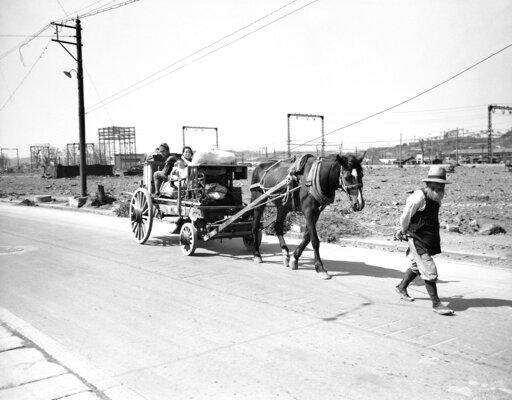
FILE - In this Oct. 11, 1945, file photo, an elderly bearded Japanese leads a horse pulling a wagon loaded with other members of the family and their household goods past the wreckage of buildings on the outskirts of Tokyo as people return to their home after having evacuated during U.S. air raids on the Japanese capital. The bombs stopped falling 75 years ago, but it is entirely possible - crucial even, some argue - to view the region's world-beating economies, its massive cultural and political reach and its bitter trade, territory and history disputes all through a single prism: Japan's aggression in the Pacific during World War II. (AP Photo/Max Desfor, File)
The Associated Press
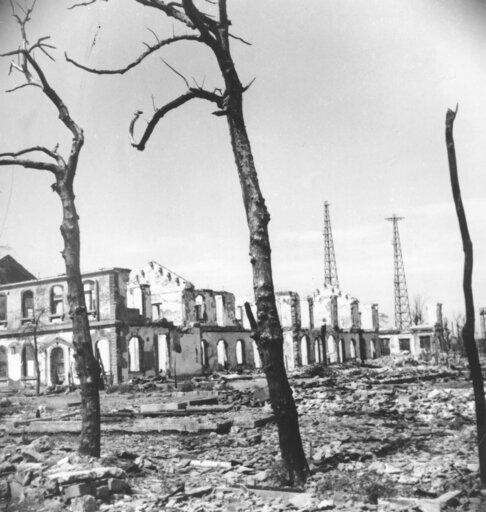
FILE - This Oct. 8, 1945, file photo shows gnarled tree branches and radio towers rearing up out of the rubble caused by bombs and fire in Tokyo during World War II. The incendiary bombs, a mixture of thermite and oxidizing agents that sometimes contained napalm, were responsible for burning over 41.5 square miles of Tokyo by the United States in March 1945. The bombs stopped falling 75 years ago, but it is entirely possible - crucial even, some argue - to view the region's world-beating economies, its massive cultural and political reach and its bitter trade, territory and history disputes all through a single prism: Japan's aggression in the Pacific during World War II. (AP Photo/Dave Davis, Pool, File)
The Associated Press
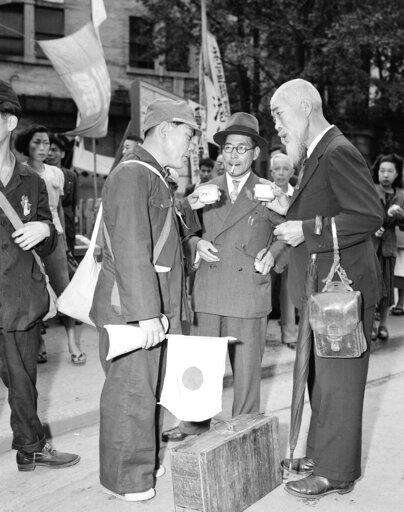
FILE - In this Oct. 7, 1949, file photo, relatives meet one of the Japanese repatriates from Manchuria and have cups of hot tea supplied by the Japanese Red Cross at the Tokyo station in Tokyo. The bombs stopped falling 75 years ago, but it is entirely possible - crucial even, some argue - to view the region's world-beating economies, its massive cultural and political reach and its bitter trade, territory and history disputes all through a single prism: Japan's aggression in the Pacific during World War II. (AP Photo, File)
The Associated Press

FILE - In this Dec. 16, 1945, file photo, Japanese repatriates, who had led a life of comparative ease in China during World War II, find themselves a bit crowded together in the holds of the S.S. Meiyu Maru, which is carrying them back to Japan from Shanghai. In accordance with Japanese custom of not wearing shoes in their homes, the repatriates remove them before crowding onto their wooden platforms. The bombs stopped falling 75 years ago, but it is entirely possible - crucial even, some argue - to view the region's world-beating economies, its massive cultural and political reach and its bitter trade, territory and history disputes all through a single prism: Japan's aggression in the Pacific during World War II. (AP Photo/Frank Filan, File)
The Associated Press
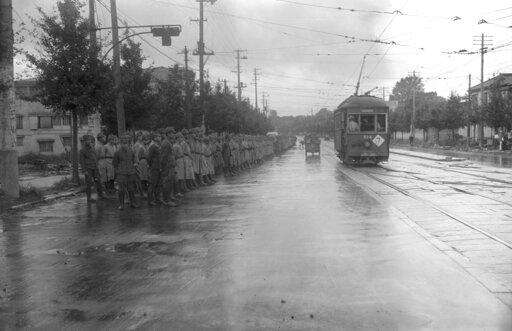
FILE - In this Aug. 31, 1945, file photo, a battalion of Japanese soldiers lines on a Tokyo street several days before American military forces officially occupy the city. The bombs stopped falling 75 years ago, but it is entirely possible - crucial even, some argue - to view the region's world-beating economies, its massive cultural and political reach and its bitter trade, territory and history disputes all through a single prism: Japan's aggression in the Pacific during World War II. (AP Photo/Frank Filan, File)
The Associated Press
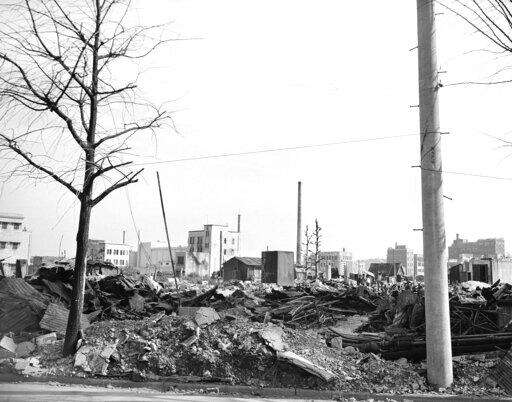
FILE - This Sept. 1, 1945, file photo shows destroyed business buildings in the city of Yokohama, near Tokyo. U.S. B-29's bombing raids left ruins debris and destruction near the American Consulate. The bombs stopped falling 75 years ago, but it is entirely possible - crucial even, some argue - to view the region's world-beating economies, its massive cultural and political reach and its bitter trade, territory and history disputes all through a single prism: Japan's aggression in the Pacific during World War II. (AP Photo/Frank Filan, Pool, File)
The Associated Press

FILE - In this Jan. 19, 1945, file photo, black smoke rises from burning targets at the Kawasaki aircraft plant in Kawasaki, near Tokyo, as U.S. planes bomb the factory facilities. The bombs stopped falling 75 years ago, but it is entirely possible - crucial even, some argue - to view the region's world-beating economies, its massive cultural and political reach and its bitter trade, territory and history disputes all through a single prism: Japan's aggression in the Pacific during World War II. (AP Photo)
The Associated Press
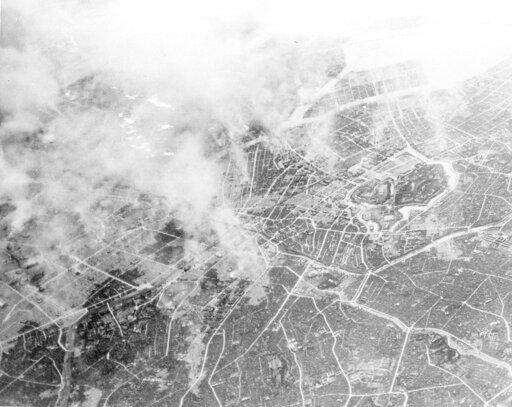
FILE - This March 10, 1945, file photo provided by photo provided by the U.S. Air Force shows plumes of smoke, rising 15,000 feet in the air several hours after Tokyo was hit by a force of more than 300 Marianas-based Superfortresses of the 21st Bomber Command. The heavy bombing burned out huge areas near the Imperial Palace, center right. The bombs stopped falling 75 years ago, but it is entirely possible - crucial even, some argue - to view the region's world-beating economies, its massive cultural and political reach and its bitter trade, territory and history disputes all through a single prism: Japan's aggression in the Pacific during World War II. (U.S. Air Force via AP, File)
The Associated Press
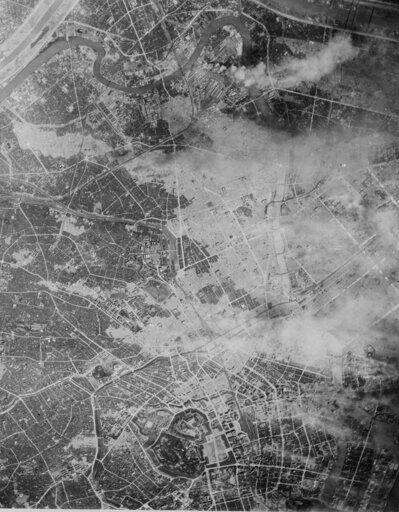
FILE - This March 10, 1945, file photo shows light sections, still smoking, several hours after a raid by more than 300 Marianas-based B-29s on Tokyo. The Imperial Palace, upper center, was undamaged, but burned up to the edge of the grounds. The bombs stopped falling 75 years ago, but it is entirely possible - crucial even, some argue - to view the region's world-beating economies, its massive cultural and political reach and its bitter trade, territory and history disputes all through a single prism: Japan's aggression in the Pacific during World War II. (AP Photo)
The Associated Press
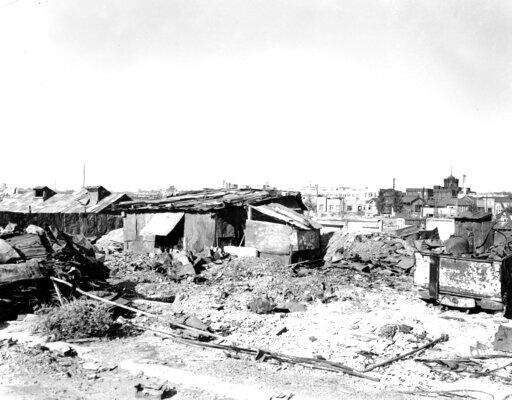
FILE - This Sept. 7, 1945, file photo shows temporary housing built from galvanized iron roofing of burned buildings in Tokyo. With the exception of the concrete downtown buildings in the background, a great part of the residential districts have been razed by incendiary and other strikes by the U.S. in March 1945. The bombs stopped falling 75 years ago, but it is entirely possible - crucial even, some argue - to view the region's world-beating economies, its massive cultural and political reach and its bitter trade, territory and history disputes all through a single prism: Japan's aggression in the Pacific during World War II. (AP Photo/Frank Filan, File)
The Associated Press
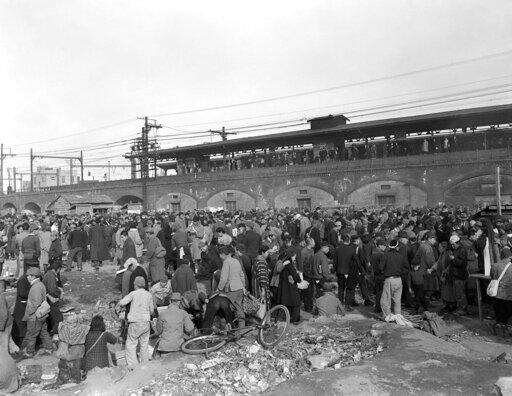
FILE - In this Dec. 16, 1945, file photo, a crowd gathers at Shimbashi railroad station in Tokyo for a hunger demonstration by residents of the city. The bombs stopped falling 75 years ago, but it is entirely possible - crucial even, some argue - to view the region's world-beating economies, its massive cultural and political reach and its bitter trade, territory and history disputes all through a single prism: Japan's aggression in the Pacific during World War II. (AP Photo/JW, File)
The Associated Press